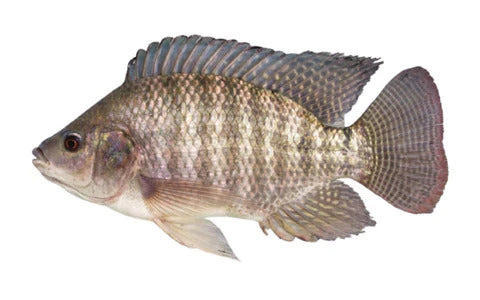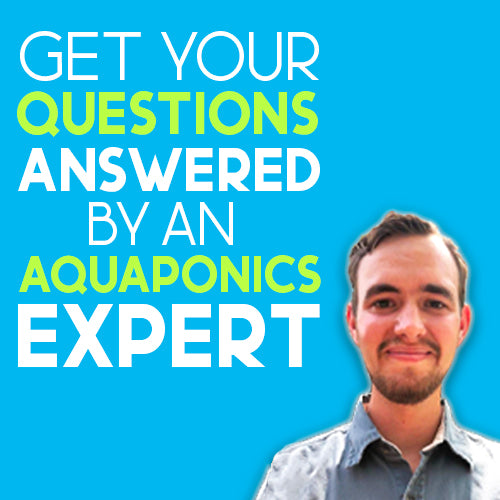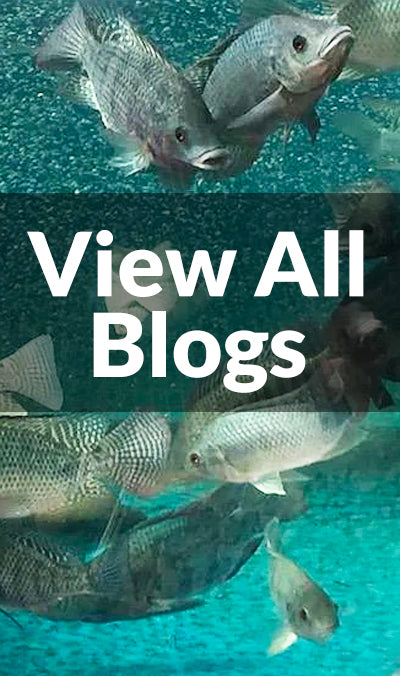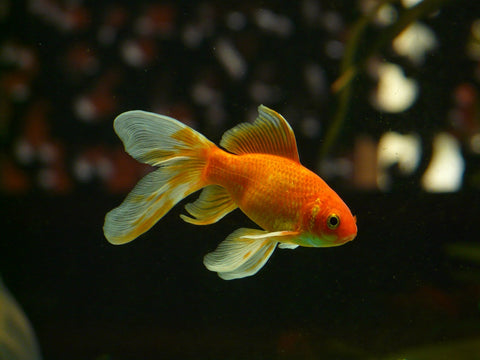At the heart of every successful aquaponics system lies a carefully chosen fish species. These aquatic companions not only provide nutrient-rich waste essential for plant growth but also contribute to the overall balance and health of the ecosystem. Selecting the right fish is crucial, as their biology and environmental needs directly impact the system's stability and productivity.
Choosing the right fish species is important to the success of an aquaponics system. The fish serve as the primary source of nutrients for the plants, and directly impact their growth and health. Factors such as the fish's feeding habits, growth rate, tolerance to environmental conditions (such as temperature and pH), and compatibility with the plants being grown must all be considered. Moreover, different fish species have varying levels of tolerance to stress and disease, which can influence the overall stability and resilience of the aquaponics ecosystem.
In this blog, we will discuss the intricacies of selecting the best fish for your aquaponics system, and offer insights into the most suitable species based on their biological traits and practical considerations. By understanding these dynamics,you can optimize their systems for productivity, sustainability, and long-term success. Whether you're an aquaponics beginner who is looking to start your first system or an experienced practitioner aiming to enhance the efficiency, choosing the right fish is a crucial step towards achieving thriving and balanced aquaponic system.
Factors to Consider When Choosing the Best Fish for Aquaponics
Selecting the best fish species for your aquaponic system involves a thoughtful assessment of several key factors to ensure harmony and productivity within the ecosystem
A. Climate and Temperature Tolerance
1. Warm-Water vs. Cold-Water Species
- Warm-Water Species: These fish thrive in higher temperatures, typically between 75°F to 85°F (24°C to 29°C). Examples include tilapia and catfish. Warm-water fish are often more suitable for indoor systems where temperatures can be controlled, or in regions with naturally warm climates.
- Cold-Water Species: These fish prefer cooler temperatures, usually between 55°F to 65°F (13°C to 18°C). Trout and perch are common cold-water species. They are ideal for outdoor systems in cooler climates or for systems where temperature control is challenging.
Understanding your local climate and the temperature range of your aquaponic system will help you select fish that will thrive without excessive energy input for heating or cooling.
B. Growth Rate and Size
1. Growth Rate:Fish with fast growth rates reach market size quickly, providing a quicker return on investment and a steady supply of nutrients for the plants. Tilapia, for instance, are known for their rapid growth under optimal conditions.
2. Size:The adult size of the fish should be considered in relation to the space available in your system. Larger fish species will require more space to thrive and can place greater demands on the system's filtration capacity. It’s important to match the fish’s growth potential with the size of your tanks and the overall capacity of your system.
C. Tank Size Requirements
1. Stocking Density:This refers to the number of fish per unit of water. High stocking densities can increase nutrient availability for plants but also require more robust filtration and aeration to maintain water quality.
2. Tank Size:Larger tanks provide more stable water conditions and allow for better growth of fish. Smaller tanks may require more frequent monitoring and maintenance to ensure water quality remains high.
Choosing the right tank size and stocking density ensures a balanced system where fish can grow healthily without overwhelming the system’s capacity to maintain clean water.
D. Reproductive Habits
- Understanding the reproductive habits of your chosen fish species is essential to avoid overpopulation. For instance, tilapia breed prolifically and can quickly overcrowd a tank if not managed properly.
- Some species, like goldfish, have more controlled breeding patterns, which can simplify population management.
Effective population control strategies, such as using all-male populations or managing breeding conditions, help maintain a balanced ecosystem.
E. Diet and Feeding
1. Compatibility with Aquaponics Plants
- The diet of the fish should complement the nutrient requirements of the plants. Carnivorous fish produce different waste profiles compared to herbivorous or omnivorous fish, which can affect the availability of nutrients like nitrogen and phosphorus for plants.
- Fish that convert feed efficiently into growth (high feed conversion ratio) will contribute more nutrients to the system, enhancing plant growth.
Selecting fish with a suitable diet ensures that the nutrient cycle remains balanced and that plants receive the necessary nutrients for optimal growth.
2. Disease Resistance and Hardiness
- Disease Resistance: Choosing fish species known for their resistance to common diseases can reduce the risk of outbreaks and the need for medical treatments. Healthy fish lead to a more stable system overall.
- Hardiness: Hardy fish are more tolerant of fluctuations in water quality parameters such as pH, ammonia, and temperature. This resilience makes them easier to care for, especially for beginners or in systems with less precise control over environmental conditions.
By choosing a disease-resistant and hardy fish, you can minimize losses and ensure a more reliable and productive aquaponic system.
The Best Fish for Aquaponics
Aquaponics enthusiasts often consider several key fish species for their systems because of their specific advantages and considerations. Here’s a detailed look at some of the top choices:
1. Tilapia

Ideal pH Range: 6.5 - 9.
Ideal Temperature Range: 82 - 86 °F
Ideal Fish Tank Size: A fully grown tilapia will weigh 1 pound, although they can grow larger. The rule of thumb is that one pound of tilapia will need 3 gallons of water. This means that in every 3 to 5 gallons of water, only raise one tilapia.
Temperature Requirements: Ensure the water temperature is suitable for tilapia, generally between 75-85°F (24-30°C).
Advantages of tilapia in aquaponics:
- Rapid Growth: Tilapia are known for their fast growth rate, making them an excellent choice for aquaponics. They reach harvestable size quickly so you can enjoy a consistent supply of fish.
- High Reproduction Rate: They reproduce readily, helping maintain a steady fish population.
- Wide Temperature Tolerance: Tilapia can adapt to various water temperatures, making them suitable for various climates.
- Hardiness: They are hardy fish that can tolerate fluctuations in water quality, making them forgiving for beginners.
- Mild Taste: Tilapia have a mild, white flesh that is palatable to most consumers, making them a popular choice for aquaponic growers.
Considerations of raising tilapia in aquaponics:
- Dietary Needs: Tilapia are primarily herbivorous but can be omnivorous to some extent.
- Warm Water: While they can adapt to varying temperatures, tilapia thrive in warmer waters. In cooler climates, you may need heating systems to maintain ideal conditions.
- Breeding: Tilapia can reproduce prolifically, which can lead to overpopulation if not managed carefully.
We Offer Two Types of Tilapia For Sale
2. Trout
Advantages of raising trout in aquaponics:
- Coldwater Compatibility: Trout prefer cooler water temperatures, making them suitable for regions with colder climates.
- High-Quality Flesh: Trout offers a delicious meat with delicate flavor and texture.
- Disease Resistance: They tend to be hardy fish with good disease resistance, provided water quality is maintained
Considerations of raising trout in aquaponics:
- Temperature Sensitivity: Trout are sensitive to temperature fluctuations, and water temperature should remain within their preferred range. This might require additional heating or cooling systems.
- Slower Growth: Compared to tilapia, trout have a slower growth rate, which means a longer time to harvest.
- Oxygen Requirements: Trout are oxygen-demanding fish, so you must ensure excellent aeration in your system.
3. Catfish
Advantages of catfish in aquaponics system:
- High Yield: Catfish are known for their substantial yield, making them popular for commercial aquaponics systems.
- Adaptability: They can tolerate a range of water qualities and are less sensitive to water parameter fluctuations.
- Omnivorous Diet: Catfish are omnivorous and can consume various foods, allowing flexibility in their diet.
Considerations for growing catfish in aquaponics:
- Water Temperature: While catfish are hardy, they do best in warm water, so maintaining suitable temperatures may be necessary.
- Size Management: Catfish can grow quite large, so ensure your system can accommodate their size.
- Handling: Catfish have sharp spines on their fins, which can cause injury if not handled carefully.
4. Largemouth Bass
Advantages of largemouth bass:
- Bass are top feeders.
- Bass eat almost anything like insects, worms, and pellets.
- They don't need much protein, giving you more food choices when feeding them.
- Great-tasting fish to eat.
Disadvantages of Largemouth Bass:
- The potassium levels of Bass need to be monitored as changes in this can make them ill.
- Their conditions must be monitored closely to ensure clean water, correct oxygen, and pH levels.
- Bass do not tolerate bright light and have poor feeding habits.
5. Salmon
Advantages of salmon:
- Delicious and healthy to eat.
- Salmon are social fish, tolerant and friendly with other fish.
- Salmon has a high tolerance for cold conditions.
Disadvantages of Salmon:
- They require more food than other fish.
- Salmon are more likely to contract diseases than many other fish species.
Other Fish Options
1. Koi
Ideal Temperature Range:65°F - 78 °F
Ideal Fish Tank Size: A 1000-gallon tank will be enough to have 6-5 koi. They are also ideally grown on ponds.
Advantages of raising koi:
- Disease and parasite resistance.
- It can survive in a wide range of temperatures.
- Ornamental and attractive fish.
- Long lifespan.
Disadvantages of raising koi:
- Not a good fish for eating.
- Needs a larger fish tank.
- It can produce excess waste as they age and require more cleaning to keep your system healthy.
2. Goldfish
Ideal pH Range:6 - 8
Ideal Temperature Range: 78°F- 82 °F
Ideal Fish Tank Size: At least a 120-gallon tank for five single-tailed goldfish.
Advantages of raising goldfish:
- Goldfish is a beautiful ornamental fish.
- Hardy fish and tolerant of pH changes.
- It can live in polluted water.
- Produce lots of beneficial waste nutrients for the plants.
Disadvantages of raising goldfish:
- You can't mix them with other fish in one tank.
- Not edible.
3. Gourami

Advantages of raising gourami in aquaponics:
- Ornamental Value: Gourami are often chosen for their vibrant colors and unique appearances, adding an aesthetic element to your aquaponics system.
- Peaceful Nature: They are generally peaceful and coexist well with other fish and plants.
- Adaptability: Gourami can adapt to a range of water conditions, making them suitable for different aquaponics setups.
Considerations of raising gourami in aquaponics:
- Non-Edible: Gourami are primarily ornamental fish and are not typically harvested for food.
- Compatibility: Ensure that gourami is compatible with the plants you intend to grow, as they have different dietary preferences than typical aquaponics fish.
- Breeding: Some gourami species are known to breed readily, so be prepared for potential population growth in your system.

Fish Care in Aquaponics Systems
A. Feeding the Fish in Aquaponics
Here's how responsible feeding practices contribute to the overall health of your aquaponic setup:
- Balanced Diet: Choosing the right fish food is essential. Opt for high-quality, nutritionally balanced feed that meets the dietary requirements of your specific fish species. Well-fed fish produce nutrient-rich waste that benefits your plants.
- Feeding Frequency: Establish a consistent feeding schedule to avoid overfeeding or underfeeding. Overfeeding can lead to excess waste and water quality issues, while underfeeding can result in nutrient deficiencies for both fish and plants.
- Monitoring Appetite: Pay attention to your fish's appetite and adjust feeding quantities accordingly. Fish may eat less during colder seasons when their metabolic rates decrease, and plants require fewer nutrients.
- Avoid Overfeeding: Overfeeding can lead to excess nutrients in the water, causing imbalances and potentially harming fish and plants. Uneaten food should be promptly removed from the system to prevent decomposition and water contamination.
B. Acclimating Fish in Aquaponics
In adding fish to the system, it is essential to acclimatize the fish first, to remove the stressful factors that can cause death to the new fish. The two simple ways of acclimating your fish are:
- Keep the new fish in a small aerated container with their original water and slowly add water from the fish tank over a day.
- Slowly allowing the temperature to equilibrate by floating the sealed transportation bags containing the fish in the fish tank for at least 15 minutes. Then slowly add a small amount of fish tank water to the transportation bag.
C. Observing Fish Health and Behavior
The primary indicator of fish health in your aquaponics system is their behavior. It is essential to recognize the behavior of your fish and look for signs of fish stress, disease, and parasites to maintain healthy fish.
Here are some important ways of maintaining healthy fish in your aquaponics system:
1. Observe fish before and after their daily feeding and note how much feed is eaten.
2. Observe and take notes of the fish's behavior and appearance daily.
3. Understand the signs of fish stress, disease, and parasites.
4. Maintain a low-stress environment with consistent good water quality, specific for the fish in the system.
5. Maintain the correct water temperature suited for the fish in the tank.
6. Use the proper stocking density and feeding rates.
Healthy Fish Behavior:
Healthy fish in your system shows the following behavior:
1. Extended fins and straight tails.
2. A graceful pattern of swimming. No lethargy. However, catfish often sleep at the bottom of the fish tank until they wake up and begin feeding.
3. A healthy appetite and not shying away at the presence of the feeder.
4. No marks, discolored blotches, streaks, or lines.
5. Not rubbing or scraping on the sides of the fish tank.
6. Sharp, clear, and shiny eyes.
D. Fish Diseases in Aquaponics
Several conditions can cause fish health problems in your aquaponics system: fish disease, parasites, fungus, and bacteria. These can all appear in your fish tank and quickly spread disastrous effects on the fish. The chance of fish disease or stress is incredibly high when you introduce new fish or add fresh water to your system, as the new fish might have brought diseases with them.
Prevention is the best way to prevent disease in fish, and recognizing the signs of fish diseases can help you avoid the loss of fish in your aquaponics system. In preventing fish disease, it is essential to check your fish regularly for any of the following signs:
- Check their appearance regularly because several parasitic and fungal infections can be visible on the fish skin, scales, or fins.
Most external signs of fish disease are:
1. Ulcers on the body surface, discolored patches, and white or black spots.
2. Fin rot, ragged fins, or exposed fin rays.
3. Abnormal body configuration, twisted spine, and deformed claws.
4. Swollen appearance and cotton-like lesions on the body.
5. Exophthalmia or swollen popped eyes.
- Check for behavior changes, such as your fish becoming lethargic, refusing to eat or changing feeding habits, changing swimming patterns, odd position in water, head or tail down, difficulty maintaining buoyancy, and fish gasping at the surface.
- If your fish looks bloated or their scales seem raised, it also indicates health concerns.
Causes of Fish Diseases
Fish diseases can be introduced by adding new fish, poor water quality, live food, invertebrates, or equipment used in the system. Like other animals, fish also carry bacteria, viruses, fungus, and parasites. Though not all these bacteria are harmful, some of these microorganisms, called pathogens, can potentially cause fish diseases.
The following factors can cause fish disease in your aquaponics system.
- Adding new fish to the system
- Environment or poor water quality
- Fish stress
- A poor or unbalanced diet
- The equipment used in the system is not suitable for the fish
- Not getting along with other fish species in the fish tank
Symptoms of diseases to look out for:
- Cloudy or swollen eyes.
- Rapid movement of the gills.
- Distended or hollow stomach.
- Opaque, clamped, or frayed fins.
- Wounds, fungus growth, patches or spots of cloudy white/grey, or color changes in the skin.
- Unusual behavior. (unusual swimming patterns, darting around the tank in an alarmed fashion, hanging at the surface or hiding away and being unusually shy).
How to Prevent Fish Diseases
- Purchase healthy fish seeds from a reputable and reliable hatchery.
- Never add unhealthy fish to the system. Examine and quarantine new fish in a separate tank for two weeks before introducing them into an established fish tank.
- Feed the fish with a good, varied, and well-balanced diet.
- Keep the water quality in your system clean, including cleaning the filter if you have one fitted to your system.
- Ensure the system is within the parameters of pH, ammonia, nitrites, and nitrates for your particular fish.
- Add extra aeration. You can rarely have too much aeration.
- Reduce the frequency of opening and closing the lid on the tank and minimize scooping fish out to inspect them.
- Treat the disease as soon as it is identified.
Conclusion
Choosing the best fish species for your aquaponics system is critical step for its success. Whether you're a beginner, setting up your first system or an experienced aquaponics enthusiast looking to optimize productivity, understanding the specific needs and characteristics of different fish species is essential.
By evaluating your specific climate conditions, balancing the nutritional needs of your plants with the waste output of your chosen fish, and adhering to local regulations, you can create a sustainable and productive aquaponics system.
Ready to take the next step in your aquaponics journey? Get expert guidance with this Aquaponics Gardening Guide Video! This comprehensive resource walks you through every stage of building and maintaining a successful system.
Check out the video and start creating your thriving aquaponics garden today!















Jazmine Montoya
February 08, 2022
What kind of High protein food would I give my catfish ?